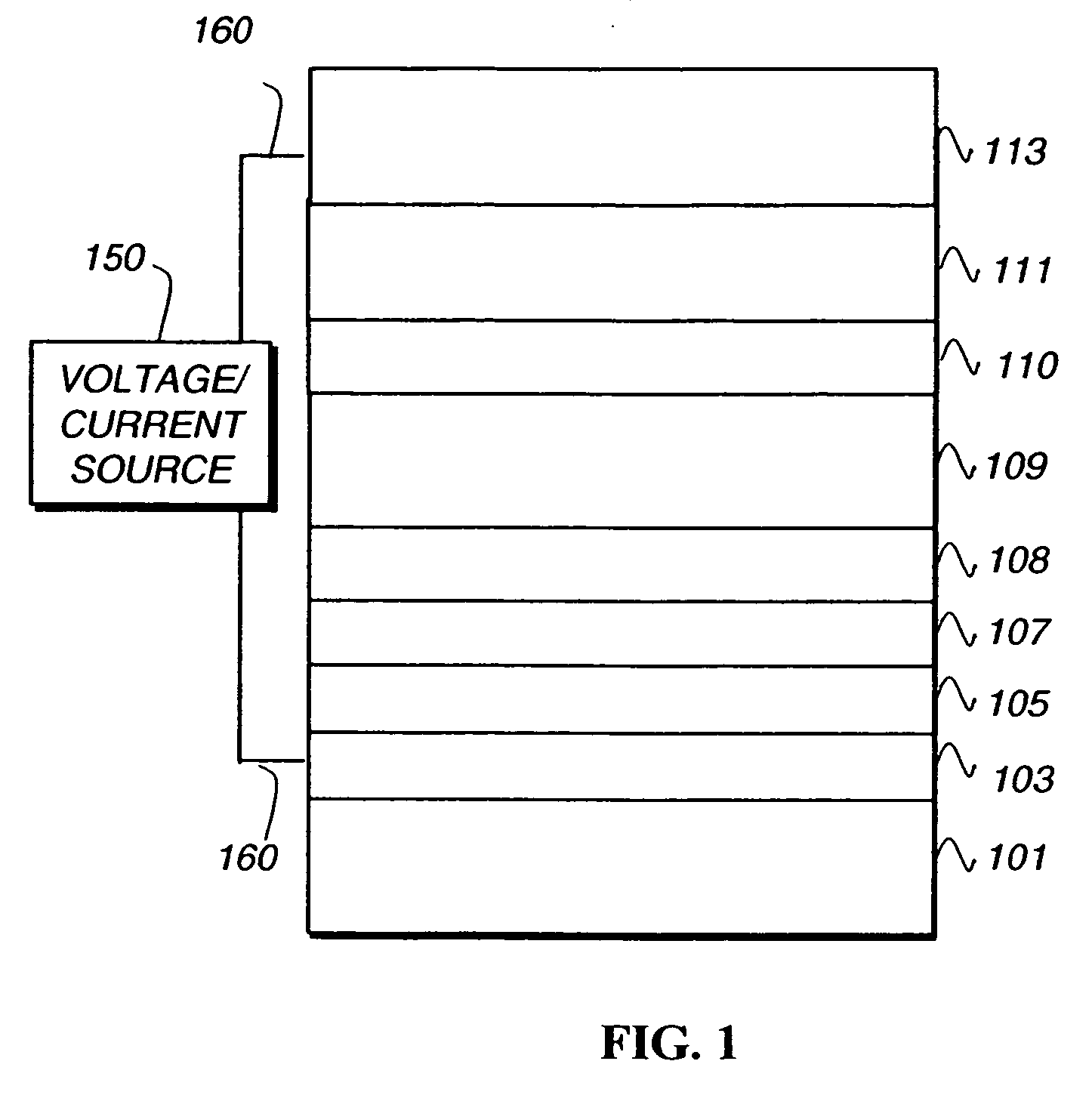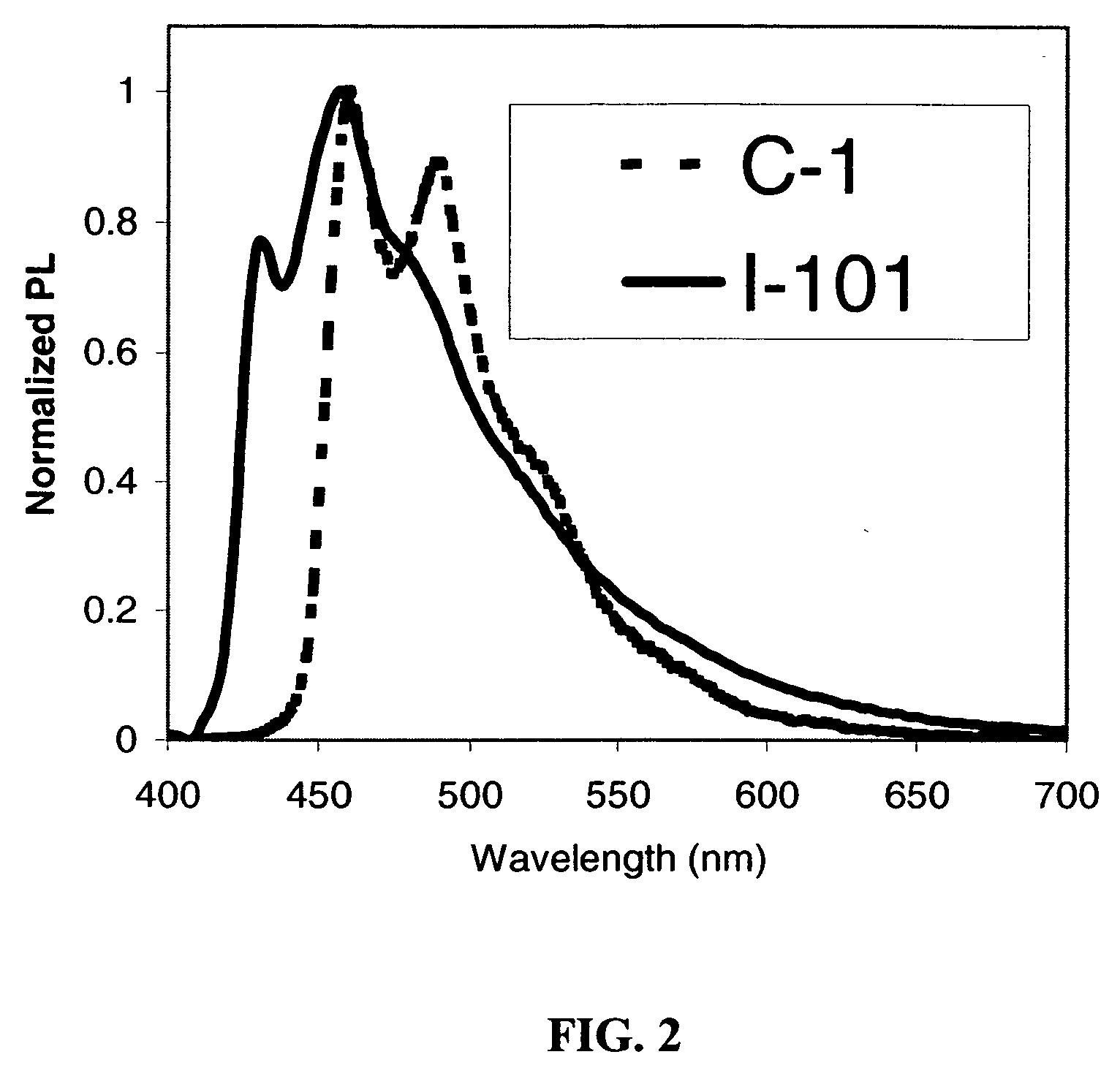Phosphorescent iridium complexes
a technology of phosphorescent iridium complexes and complexes, which is applied in the direction of discharge tube luminescnet screens, natural mineral layered products, etc., can solve the problems of large loss of efficiency and performance limitations, and hinder many desirable applications
- Summary
- Abstract
- Description
- Claims
- Application Information
AI Technical Summary
Benefits of technology
Problems solved by technology
Method used
Image
Examples
example 1
Synthesis of Transition Metal Complex I-101
Step 1
[0105] 2-(2′,4′-difluorophenyl)pyrazole (3.6 g, 20 mmol) and K3IrBr6 (6.3 g, 8 mmol) were added to a flask containing 90 ml 2-ethoxyethanol and 30 ml water. The reaction mixture was heated to reflux and stirred under a nitrogen atmosphere for 24 h. After cooling, the pale yellow precipitate was vacuum filtered and washed first with ethanol followed by heptanes. The product [2-(4′,6′-diflouorophenyl)pyrazole]2Ir2(μ-Br)2[2-(4′,6′-diflouorophenyl)pyrazole]2 was dried in vacuum oven (4.2 g, 81%).
Step 2
[0106] To a 60 ml THF suspension of potassium t-butoxide (7.9 g, 59 mmol) and 2-acetylpyridine(7.1 g, 59 mmol) was added dropwise ethyl trifluoroacetate (10 g, 70 mmol) at 10° C., and the mixture was stirred at room temperature for 15 h. After the PH value of the mixture had been adjusted to 6-7 with 10% H2SO4, the solution was extracted with Et2O. The organic layer was dried (MgSO4) and evaporated. The residue was purified by column c...
example 2
Synthesis of Transition Metal Complex C-1 (Comparison)
Step 1
[0110] 2-(2′,4′-difluorophenyl)pyridine (3.6 g, 19 mmol) and K3IrBr6 (6.3 g, 8 mmol) were added to a flask containing 90 ml 2-ethoxyethanol and 30 ml water. The reaction mixture was heated to reflux and stirred under an nitrogen atmosphere for 24 h. After cooling, the pale yellow precipitate was vacuum filtered and washed first with ethanol followed by heptanes. The product [2-(4′,6′-diflouorophenyl)pyridine]2Ir2(μ-Br)2[2-(4′,6′-diflouorophenyl)pyridine]2 was dried in vacuum oven (3.9 g, 78%).
Step 2
[0111] [2-(4′,6′-difluorophenyl)pyridine]2Ir2(μ-Br)2[2-(4′,6′-difluorophenyl)pyridine]2 (0.15 g, 0.12 mmol), 3-(pyridine-2-yl)-5-trifluoromethylpyrazole (70 mg, 0.3 mmol) and 0.2 g of K2CO3 were refluxed under an nitrogen atmosphere in 2-ethoxyethanol for 18 h. After cooling to room temperature, water was added and a white precipitate was filtered and washed with water. The crude product was chromatographed on a silicon col...
PUM
| Property | Measurement | Unit |
|---|---|---|
| Energy | aaaaa | aaaaa |
| Energy | aaaaa | aaaaa |
| Energy | aaaaa | aaaaa |
Abstract
Description
Claims
Application Information
 Login to View More
Login to View More - R&D
- Intellectual Property
- Life Sciences
- Materials
- Tech Scout
- Unparalleled Data Quality
- Higher Quality Content
- 60% Fewer Hallucinations
Browse by: Latest US Patents, China's latest patents, Technical Efficacy Thesaurus, Application Domain, Technology Topic, Popular Technical Reports.
© 2025 PatSnap. All rights reserved.Legal|Privacy policy|Modern Slavery Act Transparency Statement|Sitemap|About US| Contact US: help@patsnap.com



